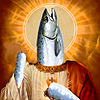HOME | DD
 artbyjrc — Never-ending variety 4 - Cypriniforms
artbyjrc — Never-ending variety 4 - Cypriniforms

#algaeeater #carp #diversity #fish #freshwater #loach #minnow #danio #mahseer #cypriniformes #goldfish
Published: 2021-11-19 09:58:23 +0000 UTC; Views: 15830; Favourites: 172; Downloads: 31
Redirect to original
Description
A selection of 23 species each representing a separate family, of carps/minnows/loaches. Not to scale.
Cypriniform fish are among the most diverse freshwater fish in the world. There are 4250 named species (with an estimated 2500 species waiting to be named) spread across over 400 genera. In particular the cyprinids (carp and minnows) contain more species than any other family of fish (or vertebrate for that matter) with around 3000 species. They are spread globally only being absent from South America, Australia and Antarctica, with the greatest diversity in South-east Asia.
In common with several other predominantly freshwater fish (known as Otophysi) - Characiniformes (characins, tetra, piranha etc) and Siluriformes (catfish; see Never-ending variety 3 - Catfish ), cypriniforms have a Webberian apparatus, a unique structure which connects the swim bladder to the auditory system. Cypriniforms differ from the other groups in possessing only a single dorsal fin and a lack of teeth in the jaws. Instead they have well developed teeth on the pharyngeal bones.
Notable species include:
* Cypriniforms include some of the smallest vertebrates in the world, including Paedocypris at 7.9mm (adult female length). The largest members of the family are mahseers Tor at up to 3 metres long.
* Zebrafish Danio rerio are a model organism for genomic research, developmental biology, medical research and drug development. It's genome has been fully sequenced.
* Various species of carp (Cyprinus carpio/rubrofuscus, Ctenopharyngodon idella and Carassius auratus) have been domesticated (as a food supply), dating from around 300 AD in China. Koi carp and goldfish are now primarily kept for decorative purposes, while common carp are among the most frequently introduced fish in the world.
* One of the longest known living organisms (and the oldest freshwater fish) is a species of catostomid. Studies of some bigmouth buffalo Ictiobus cyprinellus populations consist largely of 80 year fish with the record being an individual at 110 years.
* Primarily a freshwater group of fish, some species are known to inhabit brackish water. Several species of Tribolodon leuciscids, such as the Pacific redfin T. brandtii, are known to live in coastal environments although spawning takes place in rivers.
* Several groups show adaptations to living in fast-moving water such as mountain streams. Balitorids and gastromyzontids (both known as hillstream loaches), catostomids (suckers) and gyrinocheilids (algae-eaters) all have a ventrally located mouth and modified fins which allows the fish to temporarily attach to surface substrate (see also Sticky - Suckermouth Fish ).
* Among the various groups of subterranean and cave-living fish, cyprinids and nemacheilids (stone loaches) are the most speciose families with around 60 species each. General appearance is pink in colour with reduced eyes.
Related content
Comments: 14

👍: 1 ⏩: 1

👍: 0 ⏩: 1

👍: 1 ⏩: 0

👍: 2 ⏩: 1

👍: 1 ⏩: 0

👍: 2 ⏩: 1

👍: 0 ⏩: 0

👍: 1 ⏩: 0

👍: 1 ⏩: 1

👍: 1 ⏩: 0

👍: 1 ⏩: 1

👍: 1 ⏩: 1

👍: 1 ⏩: 1

👍: 1 ⏩: 0

















